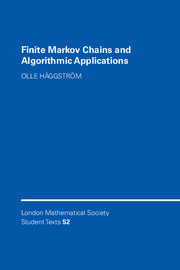Book contents
- Frontmatter
- Contents
- Preface
- 1 Basics of probability theory
- 2 Markov chains
- 3 Computer simulation of Markov chains
- 4 Irreducible and aperiodic Markov chains
- 5 Stationary distributions
- 6 Reversible Markov chains
- 7 Markov chain Monte Carlo
- 8 Fast convergence of MCMC algorithms
- 9 Approximate counting
- 10 The Propp–Wilson algorithm
- 11 Sandwiching
- 12 Propp–Wilson with read-once randomness
- 13 Simulated annealing
- 14 Further reading
- References
- Index
13 - Simulated annealing
Published online by Cambridge University Press: 29 March 2010
- Frontmatter
- Contents
- Preface
- 1 Basics of probability theory
- 2 Markov chains
- 3 Computer simulation of Markov chains
- 4 Irreducible and aperiodic Markov chains
- 5 Stationary distributions
- 6 Reversible Markov chains
- 7 Markov chain Monte Carlo
- 8 Fast convergence of MCMC algorithms
- 9 Approximate counting
- 10 The Propp–Wilson algorithm
- 11 Sandwiching
- 12 Propp–Wilson with read-once randomness
- 13 Simulated annealing
- 14 Further reading
- References
- Index
Summary
The general problem considered in this chapter is the following. We have a set S = {s1, …, sk} and a function f : S → R. The objective is to find an si ∈ S which minimizes (or, sometimes, maximizes) f (si).
When the size k of S is small, then this problem is of course totally trivial – just compute f (si) for i = 1, …, k and keep track sequentially of the smallest value so far, and for which si it was attained. What we should have in mind is the case where k is huge, so that this simple method becomes computationally too heavy to be useful in practice. Here are two examples.
Example 13.1: Optimal packing. Let G be a graph with vertex set V and edge set E. Suppose that we want to pack objects at the vertices of this graph, in such a way that
(i) at most one object can be placed at each vertex, and
(ii) no two objects can occupy adjacent vertices,
and that we want to squeeze in as many objects as possible under these constraints. If we represent objects by 1's and empty vertices by 0's, then, in the terminology of Example 7.1 (the hard-core model), the problem is to find (one of) the feasible configuration(s) ξ ∈ {0, 1}V which maximizes the number of 1's. […]
- Type
- Chapter
- Information
- Finite Markov Chains and Algorithmic Applications , pp. 99 - 107Publisher: Cambridge University PressPrint publication year: 2002



